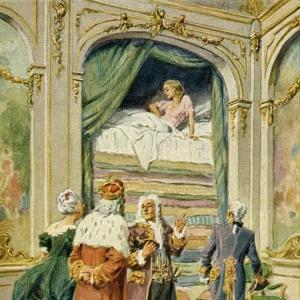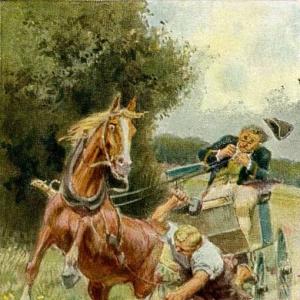Reading time: 11 min
Master Pfriem was a short, thin, but lively man, who never rested a moment. His face, of which his turned-up nose was the only prominent feature, was marked with small-pox and pale as death, his hair was gray and shaggy, his eyes small, but they glanced perpetually about on all sides. He saw everything, criticised everything, knew everything best, and was always in the right. When he went into the streets, he moved his arms about as if he were rowing; and once he struck the pail of a girl, who was carrying water, so high in the air that he himself was wetted all over by it. „Stupid thing,“ cried he to her, while he was shaking himself, „couldst thou not see that I was coming behind thee?“ By trade he was a shoemaker, and when he worked he pulled his thread out with such force that he drove his fist into every one who did not keep far enough off. No apprentice stayed more than a month with him, for he had always some fault to find with the very best work. At one time it was that the stitches were not even, at another that one shoe was too long, or one heel higher than the other, or the leather not cut large enough. „Wait,“ said he to his apprentice, „I will soon show thee how we make skins soft,“ and he brought a strap and gave him a couple of strokes across the back. He called them all sluggards. He himself did not turn much work out of his hands, for he never sat still for a quarter of an hour. If his wife got up very early in the morning and lighted the fire, he jumped out of bed, and ran bare-footed into the kitchen, crying, „Wilt thou burn my house down for me? That is a fire one could roast an ox by! Does wood cost nothing?“ If the servants were standing by their wash-tubs and laughing, and telling each other all they knew, he scolded them, and said, „There stand the geese cackling, and forgetting their work, to gossip! And why fresh soap? Disgraceful extravagance and shameful idleness into the bargain! They want to save their hands, and not rub the things properly!“ And out he would run and knock a pail full of soap and water over, so that the whole kitchen was flooded. Someone was building a new house, so he hurried to the window to look on. „There, they are using that red sand-stone again that never dries!“ cried he. „No one will ever be healthy in that house! and just look how badly the fellows are laying the stones! Besides, the mortar is good for nothing! It ought to have gravel in it, not sand. I shall live to see that house tumble down on the people who are in it.“ He sat down, put a couple of stitches in, and then jumped up again, unfastened his leather-apron, and cried, „I will just go out, and appeal to those men’s consciences.“ He stumbled on the carpenters. „What’s this?“ cried he, „you are not working by the line! Do you expect the beams to be straight?–one wrong will put all wrong.“ He snatched an axe out of a carpenter’s hand and wanted to show him how he ought to cut; but as a cart loaded with clay came by, he threw the axe away, and hastened to the peasant who was walking by the side of it: „You are not in your right mind,“ said he, „who yokes young horses to a heavily-laden cart? The poor beasts will die on the spot.“ The peasant did not give him an answer, and Pfriem in a rage ran back into his workshop. When he was setting himself to work again, the apprentice reached him a shoe. „Well, what’s that again?“ screamed he, „Haven’t I told you you ought not to cut shoes so broad? Who would buy a shoe like this, which is hardly anything else but a sole? I insist on my orders being followed exactly.“ Master,“ answered the apprentice, „you may easily be quite right about the shoe being a bad one, but it is the one which you yourself cut out, and yourself set to work at. When you jumped up a while since, you knocked it off the table, and I have only just picked it up. An angel from heaven, however, would never make you believe that.“
One night Master Pfriem dreamed he was dead, and on his way to heaven. When he got there, he knocked loudly at the door. „I wonder,“ said he to himself, „that they have no knocker on the door, — one knocks one’s knuckles sore.“ The apostle Peter opened the door, and wanted to see who demanded admission so noisily. „Ah, it’s you, Master Pfriem;“ said he, „well, I’ll let you in, but I warn you that you must give up that habit of yours, and find fault with nothing you see in heaven, or you may fare ill.“ – „You might have spared your warning,“ answered Pfriem. „I know already what is seemly, and here, God be thanked, everything is perfect, and there is nothing to blame as there is on earth.“ So he went in, and walked up and down the wide expanses of heaven. He looked around him, to the left and to the right, but sometimes shook his head, or muttered something to himself. Then he saw two angels who were carrying away a beam. It was the beam which some one had had in his own eye whilst he was looking for the splinter in the eye of another. They did not, however, carry the beam lengthways, but obliquely. „Did any one ever see such a piece of stupidity?“ thought Master Pfriem; but he said nothing, and seemed satisfied with it. „It comes to the same thing after all, whichever way they carry the beam, straight or crooked, if they only get along with it, and truly I do not see them knock against anything.“ Soon after this he saw two angels who were drawing water out of a well into a bucket, but at the same time he observed that the bucket was full of holes, and that the water was running out of it on every side. They were watering the earth with rain. „Hang it,“ he exclaimed; but happily recollected himself, and thought, „Perhaps it is only a pastime. If it is an amusement, then it seems they can do useless things of this kind even here in heaven, where people, as I have already noticed, do nothing but idle about.“ He went farther and saw a cart which had stuck fast in a deep hole. „It’s no wonder,“ said he to the man who stood by it; „who would load so unreasonably? what have you there?“ – „Good wishes,“ replied the man, „I could not go along the right way with it, but still I have pushed it safely up here, and they won’t leave me sticking here.“ In fact an angel did come and harnessed two horses to it. „That’s quite right,“ thought Pfriem, „but two horses won’t get that cart out, it must at least have four to it.“ Another angel came and brought two more horses. She did not, however, harness them in front of it, but behind. That was too much for Master Pfriem, „Clumsy creature,“ he burst out with, „what are you doing there? Has any one ever since the world began seen a cart drawn in that way? But you, in your conceited arrogance, think that you know everything best.“ He was going to say more, but one of the inhabitants of heaven seized him by the throat and pushed him forth with irresistible strength. Beneath the gateway Master Pfriem turned his head round to take one more look at the cart, and saw that it was being raised into the air by four winged horses.
At this moment Master Pfriem awoke. „Things are certainly arranged in heaven otherwise than they are on earth,“ said he to himself, „and that excuses much; but who can see horses harnessed both behind and before with patience; to be sure they had wings, but who could know that? It is, besides, great folly to fix a pair of wings to a horse that has four legs to run with already! But I must get up, or else they will make nothing but mistakes for me in my house. It is a lucky thing for me though, that I am not really dead.“
 Learn languages. Double-tap on a word.Learn languages in context with Childstories.org and Deepl.com.
Learn languages. Double-tap on a word.Learn languages in context with Childstories.org and Deepl.com.Backgrounds
Interpretations
Adaptions
Summary
Linguistics
„Master Pfriem“ is a lesser-known fairy tale by the Brothers Grimm, who were German academics, philologists, and cultural researchers, known for their extensive work in collecting and publishing traditional folktales. The story is included in their famous collection, „Grimm’s Fairy Tales,“ which was first published in 1812.
The Brothers Grimm, Jacob and Wilhelm, aimed to preserve the traditional stories of their time, as they believed that these tales were an essential part of their cultural heritage. Their collection of folktales became popular worldwide, and the stories have been translated into many languages, adapted into various forms of media, and used as inspiration for countless other works.
„Master Pfriem“ shares common themes and moral lessons with other stories in the Grimm’s collection, such as the importance of humility, the value of different perspectives, and the consequences of excessive criticism. The story, like many other Grimm’s tales, serves as a cautionary tale that imparts valuable life lessons to readers.
„Master Pfriem“ can be interpreted in several ways, offering valuable insights into human nature and behavior. Here are three possible interpretations:
The dangers of arrogance and pride: One key message in the story is the danger of being overly arrogant and prideful, as demonstrated by Master Pfriem’s inability to recognize the value in others‘ work or methods. He always assumes he knows best, which leads to conflict with others and ultimately his expulsion from heaven. This tale serves as a reminder to be humble and open-minded, recognizing that there may be multiple valid approaches to solving problems or completing tasks.
The importance of embracing different perspectives: The story also highlights the importance of understanding and accepting that different people have different perspectives, and that what may seem strange or illogical to one person might make perfect sense to another. In heaven, Master Pfriem is confronted with situations that defy his earthly logic but serve a purpose in the heavenly realm. By learning to accept that there are multiple ways of viewing and approaching situations, one can foster greater empathy and cooperation.
The consequences of constant criticism: Master Pfriem’s constant criticism and fault-finding not only create conflict with others but also prevent him from fully enjoying his experiences, including his dream of heaven. His inability to restrain his critical nature ultimately leads to his banishment. This tale serves as a cautionary example of the negative effects of excessive criticism, both on oneself and on relationships with others. It encourages readers to practice understanding, empathy, and kindness, rather than constantly seeking out and pointing out flaws.
There are not many adaptations of the fairy tale „Master Pfriem“ compared to some of the more well-known Grimm tales, but here are a few notable ones:
„Master Pfreim“- A short animated film adaptation of the story was made by director Michael Sieber in 2006. The film updates the story to a contemporary setting, with the titular character portrayed as an impoverished artist who is conned by a wealthy businessman.
„The Empty Chest“- A version of the story was included in Andrew Lang’s „The Blue Fairy Book“ in 1889 under the title „The Empty Chest.“ This version is similar to the Grimm tale but has some minor variations in the plot.
„Der gestiefelte Kater“- The story of a clever cat who helps his master win a princess’s hand in marriage is the basis for Charles Perrault’s „Puss in Boots,“ which shares some similarities with „Master Pfriem.“ The story has been adapted into several films, TV shows, and stage productions over the years.
„The House with the Golden Windows“- In this version of the story by Laura E. Richards, a poor but honest family is tricked by a clever cat into giving up their home. However, unlike the Grimm tale, the family is ultimately able to outsmart the cat and regain their home and possessions.
Overall, while „Master Pfriem“ may not be as widely adapted as some of the other Grimm tales, its themes of greed, gullibility, and the consequences of making foolish decisions continue to resonate with audiences today.
„Master Pfriem“ is a fairy tale by the Brothers Grimm about a lively, short, and thin man named Master Pfriem, who is a shoemaker by trade. He is a critical, impatient, and overbearing person who always believes he knows best and is constantly finding fault with everything and everyone around him.
One day, after finding fault with various people and their work, Master Pfriem dreams that he has died and gone to heaven. He is warned by the apostle Peter to not criticize anything he sees in heaven, lest he suffer consequences. Master Pfriem promises to behave, but as he walks through heaven, he can’t help but notice and criticize various oddities, like angels carrying a beam the wrong way and others drawing water with a hole-riddled bucket.
He becomes particularly incensed when he sees a cart stuck in a hole and loaded with „good wishes.“ Four angels come to help, but they harness the horses in an unconventional way, with two in the front and two in the back. Unable to contain his frustration, Master Pfriem criticizes the angels and is promptly thrown out of heaven.
Upon waking, Master Pfriem realizes that things in heaven are different from those on earth, but he still can’t understand the reasoning behind the odd occurrences he witnessed in his dream. Relieved that he is not actually dead, he resolves to continue managing his household to prevent mistakes from happening.
The story highlights the importance of humility and understanding that one’s own perspective may not always be the best or only way of doing things.
The fairy tale „Master Pfriem“ by the Brothers Grimm features a character characterized by his incessant need to critique and find fault in everything around him. A linguistic analysis of this story can unravel several layers of meaning and stylistic choices that contribute to the portrayal of Master Pfriem and the narrative as a whole.
Characterization through Language
Description and Physicality: Master Pfriem is depicted with strong physical and behavioral descriptions. Words like „short,“ „thin,“ and „lively“ create a vivid image of a man who is constantly in motion. His „turned-up nose“ and „small-pox“ marked skin add to his distinctiveness. This detailed physical description is typical of Grimm’s fairy tales, where characters are often painted in bold, memorable strokes to reinforce their personas.
Speech and Critique: The use of direct speech lets readers experience Pfriem’s constant criticism firsthand. His language is often commanding and accusatory, as seen in phrases like, „Stupid thing!“ and „Clumsy creature. “ The imperative tone underscores his self-assigned authority and perceived superiority.
Structural Elements
Repetition: The story employs repetition effectively to accentuate Pfriem’s persistent nature. His criticisms of others, be it the girl with the water pail, his apprentices, or the people working on the house, are repetitive in theme, thus reinforcing his critical character. This repetition also mirrors the cyclical nature of his grievances, showing that his dissatisfaction is habitual and perhaps irrational.
Contrast and Irony: There’s a clear contrast between Pfriem’s earthly experience and his dreamt experience in heaven. On earth, his criticisms are met with disdain and frustration from those around him. However, in heaven, his critical nature leads to his expulsion. The irony is rich in the scene where he criticizes heavenly beings, only to be shown that his understanding is limited. This highlights a moral lesson about arrogance and the human tendency to judge without full understanding.
Thematic Considerations
Perfection and Imperfection: The theme of perfection versus imperfection runs throughout the tale. Master Pfriem is obsessed with finding faults, hinting at his personal quest for perfection in an imperfect world. In heaven, where everything should be „perfect,“ his criticisms reveal his inability to comprehend that imperfections can have a purpose, challenging the reader’s perception of what true perfection entails.
Authority and Knowledge: The story questions the nature of expertise and authority. Pfriem’s self-assurance and conviction that he knows best are challenged both by his earthly experiences and heavenly encounters. His character serves as a critique of those who assert authority without the willingness to understand different perspectives or knowledge beyond their own.
Symbolism
The Beam and the Splinter: The reference to the beam and splinter is a biblical allusion, reinforcing themes of hypocrisy and self-awareness. It symbolizes Pfriem’s flaw of seeing faults in others while being blind to his own.
Winged Horses: The winged horses symbolize transcendence and divine logic that surpasses human understanding. Pfriem’s failure to comprehend their significance underlines his earthly limitations and inability to perceive beyond conventional wisdom.
Overall, „Master Pfriem“ uses linguistic and narrative elements to craft a story that is both a character study and a moral lesson on the human propensity to judge hastily and arrogantly. The Brothers Grimm leverage descriptive language, repetition, irony, and symbolism to highlight the follies of perfectionism and misplaced authority.
Information for scientific analysis
Fairy tale statistics | Value |
|---|---|
| Number | KHM 178 |
| Aarne-Thompson-Uther-Index | ATU Typ 801 |
| Translations | DE, EN, DA, ES, FR, PT, IT, JA, NL, PL, RU, TR, VI, ZH |
| Readability Index by Björnsson | 29.3 |
| Flesch-Reading-Ease Index | 81.9 |
| Flesch–Kincaid Grade-Level | 6.3 |
| Gunning Fog Index | 9 |
| Coleman–Liau Index | 7.8 |
| SMOG Index | 8.4 |
| Automated Readability Index | 6.4 |
| Character Count | 7.567 |
| Letter Count | 5.797 |
| Sentence Count | 81 |
| Word Count | 1.448 |
| Average Words per Sentence | 17,88 |
| Words with more than 6 letters | 166 |
| Percentage of long words | 11.5% |
| Number of Syllables | 1.828 |
| Average Syllables per Word | 1,26 |
| Words with three Syllables | 66 |
| Percentage Words with three Syllables | 4.6% |

 Facebook
Facebook  Whatsapp
Whatsapp  Messenger
Messenger  Telegram
Telegram Reddit
Reddit














